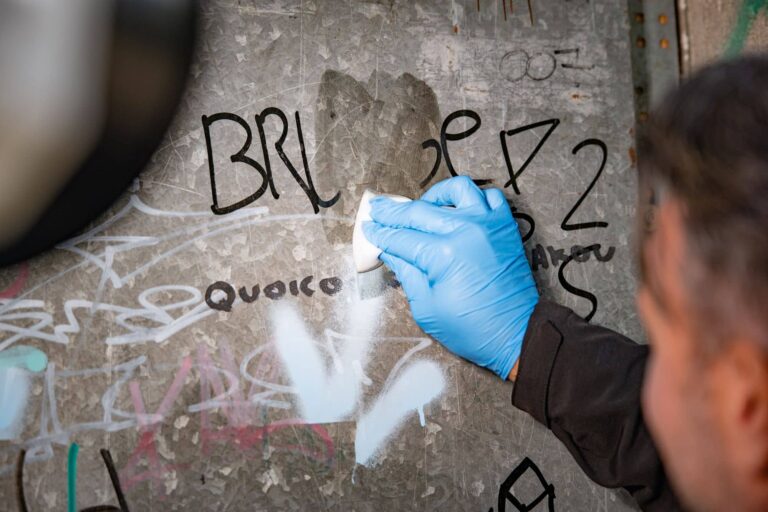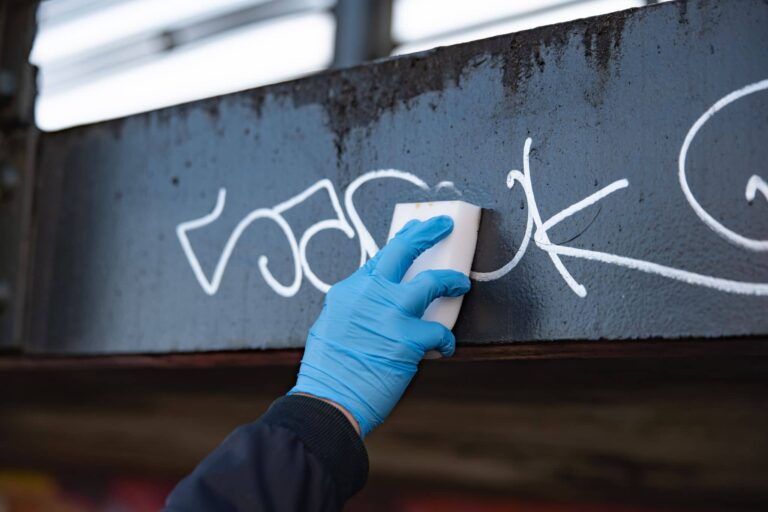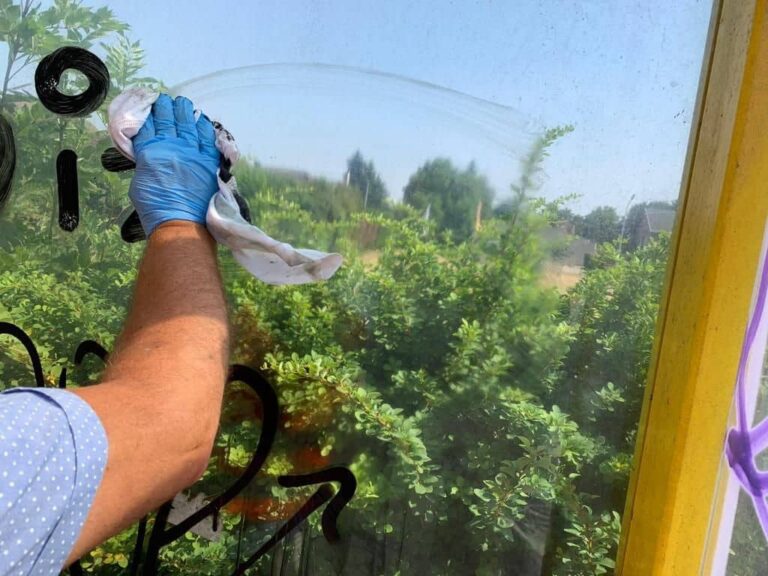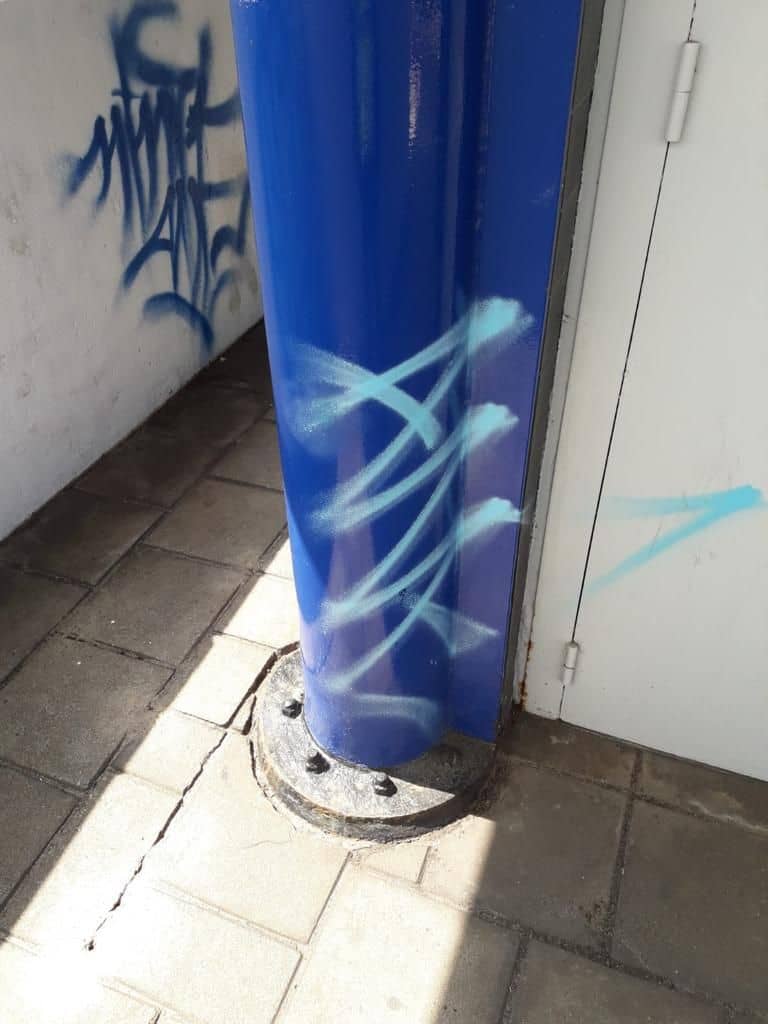Ink Removal:
An overview of ink-based graffiti and their removal
- Ko van den Boom
- Reading time: 29 minutes
- Graffiti removal, Methods, Vandalism

Removal of ink from permanent markers paint pens and similar writing utensils
Graffiti can be a vibrant form of artistic expression, but when it crosses the line into vandalism, it becomes a significant concern for property owners and municipalities which usually have to take care of hiring professionals for cleaning up. Regardless of your stance, the reality is that unwanted graffiti can deface property, contain hurtful and/or racist language, lower property values, and create a sense of urban decay.
In this blog post, we’ll focus on the removal of ink graffiti made with permanent markers, paint markers, gel pens invisible pens and other similar writing tools usually used by vandals to create graffiti on mostly smooth surfaces, but to some extent also walls and other porous substrates.
We will overview the basics:
most common utensils and types of ink used by vandals (excluding tools used by vandals to create
– regular graffiti” like spray cans, etc.)
– places where ink graffiti are most likely to occur
– methods usually adopted for effective removal of ink-based graffiti
What we will NOT discuss in this post about ink graffiti removal
It is important to note what this blog post is not about. Most of the searches on the internet about ink removal yield results about removing ink from textile and similar materials. This blog post DOES NOT address this topic. We also WILL NOT speak about graffiti removal in general (for example spray paint graffiti). We will only address the specific issue of removal of ink that is used by vandals to create graffiti (mostly) on exteriors and interiors of public spaces and infrastructure such as rolling stock, public bathrooms, classrooms etc., using pens, markers and similar writing/drawing utensils. If you are interested in the subject of removal of “classic” graffiti, read our blog post about this subject. Understanding Ink-Based Graffiti Ink-based graffiti typically involves mediums like permanent markers, paint markers, and UV-reactive invisible pens. The inks used in these tools are specifically formulated for durability and adhesion, which
Contents
Ko van den Boom
Main Categories
Main Categories
Understanding Ink-Based Graffiti
Ink-based graffiti typically involves mediums like permanent markers, paint markers, and UV-reactive invisible pens. The inks used in these tools are specifically formulated for durability and adhesion, which makes them challenging to remove once applied to surfaces. Their waterproof properties and resistance to fading mean that standard cleaning methods (like using commercial cleaning products) will mostly not work, especially not on such a scale that would be satisfactory for cleaning professionals. These tools are favoured by vandals for their portability and ability to leave marks on a wide range of (preferably, but not exclusively, smooth) surfaces
Types of writing utensils most commonly used for ink graffiti
Below we mention just a few of the various types of writing and drawing utensils that vandals can use. The combinations of tip sizes (from extra fine tip markers to extremely wide jumbo markers), tip shapes and types of ink contained in them, creates a variety of different ink residue. Each has its own particularities and removal challenges, which are further complicated by the type of surface they adhered to.
1. Various types of Permanent Markers (Alcohol-Based):
- These markers use a solvent-based ink that adheres well to smooth surfaces and dries quickly, making them a popular choice for graffiti.
2. Various types of Paint Markers:
Note: Both paint and permanent markers come with various types of tips to create different effects and line thicknesses. Amongst the most used are:
- Felt Tip Markers allow for various thicknesses depending on the angle used
- Mop Markers: Designed for big, dripping tags, they excel on smooth surfaces like metal and glass, but can be applied to porous surfaces too.
3. Steel Tip Paint Markers: These markers have a durable tip and work well on smooth surfaces
- while allowing for precise application. They can be both alcohol or acrylic based.
4. Invisible or stealth Pens:
- While less common, these pens can leave marks that become visible after reacting with UV from sunlight. The reaction breaks silver nitrate down into nitric acid, which damages/etches the surface, and silver oxide, which forms a black/brown residue. This combination of factors makes the residue from thes utensils very, very difficult to remove (if not impossible). In locations where these types of vandal acts are common preventive measures should be a must.
5. DIY mixed markers or »acid markers«.
- Vandals are known to mix inks with acids to damage surfaces, making their tags even harder to remove. We call these »acid markers«.
Types of pens that are generally not suitable for ink graffiti because while they work verry well on paper, they don’t adhere that well on smooth surfaces:
- Ballpoint Pens: While they can leave marks, their oil-based ink is not designed for adherence to non-porous surfaces.
- Rollerball Pens: Similar to ballpoints, they typically do not adhere well to smooth surfaces.
- Fountain Pens: The water-based inks used in fountain pens do not provide the necessary adhesion
- Gel Pens: While of vibrant colours, gel inks will not have permanence on non-porous surfaces and can smudge easily.
Where Ink-Based Graffiti is Most Likely to Occur
Ink-based graffiti is frequently found in areas that are highly visible yet offer quick escape routes for vandals. These include public transit systems such as buses, trains, and subways, where smooth surfaces like glass windows, metal panels, and plastic seats are common targets. Urban infrastructure such as street signs, utility boxes, and vending machines also face frequent tagging due to their accessibility.
Schools, shopping centres, and parking garages are popular locations, as they often provide expansive, unattended spaces. In residential areas, fences, walls, and mailboxes are frequent targets, particularly in places with low foot traffic or poor lighting, which create opportunities for unobstructed vandalism. In picking their spots for ink-based graffiti, vandals combine the factor of high visibility with relative closedness so that the action of the deed remains unseen, that is why ink graffiti can be found both in high traffic areas, obscure corners and (semi)abandoned places
Types of writing utensils most commonly used for ink graffiti
Below we mention just a few of the various types of writing and drawing utensils that vandals can use. The combinations of tip sizes (from extra fine tip markers to extremely wide jumbo markers), tip shapes and types of ink contained in them, creates a variety of different ink residue. Each has its own particularities and removal challenges, which are further complicated by the type of surface they adhered to.
1. Various types of Permanent Markers (Alcohol-Based):
- These markers use a solvent-based ink that adheres well to smooth surfaces and dries quickly, making them a popular choice for graffiti.
2. Various types of Paint Markers:
Note: Both paint and permanent markers come with various types of tips to create different effects and line thicknesses. Amongst the most used are:
- Felt Tip Markers allow for various thicknesses depending on the angle used
- Mop Markers: Designed for big, dripping tags, they excel on smooth surfaces like metal and glass, but can be applied to porous surfaces too.
3. Steel Tip Paint Markers: These markers have a durable tip and work well on smooth surfaces
- while allowing for precise application. They can be both alcohol or acrylic based.
4. Invisible or stealth Pens:
- While less common, these pens can leave marks that become visible after reacting with UV from sunlight. The reaction breaks silver nitrate down into nitric acid, which damages/etches the surface, and silver oxide, which forms a black/brown residue. This combination of factors makes the residue from thes utensils very, very difficult to remove (if not impossible). In locations where these types of vandal acts are common preventive measures should be a must.
5. DIY mixed markers or »acid markers«.
- Vandals are known to mix inks with acids to damage surfaces, making their tags even harder to remove. We call these »acid markers«.
Types of pens that are generally not suitable for ink graffiti because while they work verry well on paper, they don’t adhere that well on smooth surfaces:
- Ballpoint Pens: While they can leave marks, their oil-based ink is not designed for adherence to non-porous surfaces.
- Rollerball Pens: Similar to ballpoints, they typically do not adhere well to smooth surfaces.
- Fountain Pens: The water-based inks used in fountain pens do not provide the necessary adhesion
- Gel Pens: While of vibrant colours, gel inks will not have permanence on non-porous surfaces and can smudge easily.
The challenges in removing ink graffiti
Ink-based graffiti presents a unique set of challenges. These inks are formulated for maximum adhesion and permanence, often making them difficult to remove. The other big challenge for ink removal is the materials the ink graffiti are made on. The surfaces vary greatly and many of them have special coatings or finishes to give them specific properties. Examples include traffic signs, which have reflective properties; urban infrastructure which is protected with specific coatings, like inox handless and elevator doors; screens of ATM’s, vending machines and other screens that have anti-glare films; Plexiglas windows etc.
Ink graffiti removal methods
As with other types of graffiti, for ink graffiti too, usually a combination of mechanical and chemical methods is adopted.
Mechanical methods don’t work on their own
While mechanical methods must be put to use in combination with chemistry, these almost never work by themselves. Rubbing, wiping, scrubbing and scraping will never get the job done because it will either be ineffective or it will damage the surface, which defies the whole purpose of cleaning.
Pressure washing and sandblasting
While these two approaches could yield some results in some circumstances, if the pressure and mediums would be properly adjusted not to cause damage to the surface, they often are not of use, because the surfaces where ink graffiti are made on are more often than not located indoors – inside trains, busses, classrooms and public toilets and around electrical circuits that could be damaged as a consequence of cleaning with these mechanical methods.
Chemical methods for ink removal
These methods are the ones most used by professionals, because the cleaning agent can be in formats that are easier to control, like gels that don’t drip and liquids which can be applied with brushes, sponges or cloths.
Home remedies like rubbing alcohol, acetone and baking soda solutions will only have a verry limited effect. Whilst they could be used at home, for minimal cleaning efforts, they will never be in the arsenal of graffiti cleaning professionals who need consistent approaches that can be adopted for any dimension of
surface and that can be adjusted to the specifics of the substrate they have to deal with.
Chemical ink removers and expertise
Cleaning professionals usually use specialised ink removal products that are specifically designed for these kinds of tasks. It is important to note that expertise is of the essence. Having a product is not enough if you don’t know all of its specifics, you don’t have knowledge about the substrate you want to clean and how it reacts to the ingredients of the product you choose.
Professional Ink removal products
Specifical ink removal products are the go-to of professional cleaning services for safe and fast Ink removal. These products are usually based on special solvents and surfactants designed for removing various types of inks, such as permanent marker ink, felt pen ink, etc.
Some professional ink removers are designed to work on smooth surfaces only, while others can be effective on both porous and non-porous surfaces. The most innovative products for Ink removal are also biodegradable, low-VOC (reduced amount of Volatile Organic Compounds) and not harmfull to the user which makes them also more environment friendly. One such line of products is Mavro International’s Ink removers which come in two formats: liquid and gel. The first is meant to be used on smooth surfaces only, while the latter can be used on both porous and nonporous surfaces. Before deciding which product
to use, professional evaluation of the surface and its circumstances needs to be carried out, this is why it is a good idea to contact the producer to get specific information about the products’ characteristics.
General principles for Ink removal process
- Disclaimer: here we will only present the general principles usually (!) used in ink removal processes. As mentioned before, experienced professionals should handle these products and decide about the use of appropriate application methods, product types, quantities, drying times etc. in order to avoid damaging the surface. So, you should note that this is not definitive practical advice, but just an overview.
- Evaluation of the surface.
Recognising the material and all of its characteristics is crucial because this means that we are also aware the properties that might not be obvious at first sight, but without them the material would cease to exert its function – like the reflective properties of a traffic sign. - Preparation.
This is key for a smooth work process without interruptions. Professionals usually prepare all the gear (tools and protective equipment) and products they will need and put in place protective rolls or other materials they use for protection of neighbouring objects and floors. - Testing first.
The product and method are always tested on an inconspicuous area to check for consistency and any potential adverse reactions. This is a must before going into application of large(er) quantities of product. - Application.
Types of application can vary based on factors like:
- Surface dimension (removing many small tags interspersed calls for a completely different approach than removing a larger surface entirely covered with ink.)
- Type of ink to be removed
- Type of product (in terms of viscosity and other characteristics, like the strength of the solvents contained etc.)
- Weather conditions like temperature, moisture levels, wind strength, etc.
- Other factors might also apply
5. Removing the residue product and ink.
Depending on the product used it might be necessary to wipe the residue or washing, rinsing and drying it after that.
Preventive measures for ink-based graffit
As far as preventive measures are concerned, the approaches to protecting surfaces from ink graffiti and making ink removal faster and easier is more or less the same as with measures for adopted for all other kinds of graffiti. Read more about it in our blog post Types of graffiti prevention.
Conclusion
Take ink removal seriously
Even if tags made with writing utensils seem to be less of a problem compared to spray paint graffiti, this is rarely the case. Ink may be made of chemical compounds that are less resistant than some paints, but it is other factors and circumstances (like where ink graffiti occurs and the specifics of the underlying substrates) that can make the removal process even more difficult at times. This is why the best approaches for ink removal must include professionals of the trade. If you have graffiti ink removal projects ahead of you, can contact us to get professional advice about the appropriate products to buy and services to hire.







